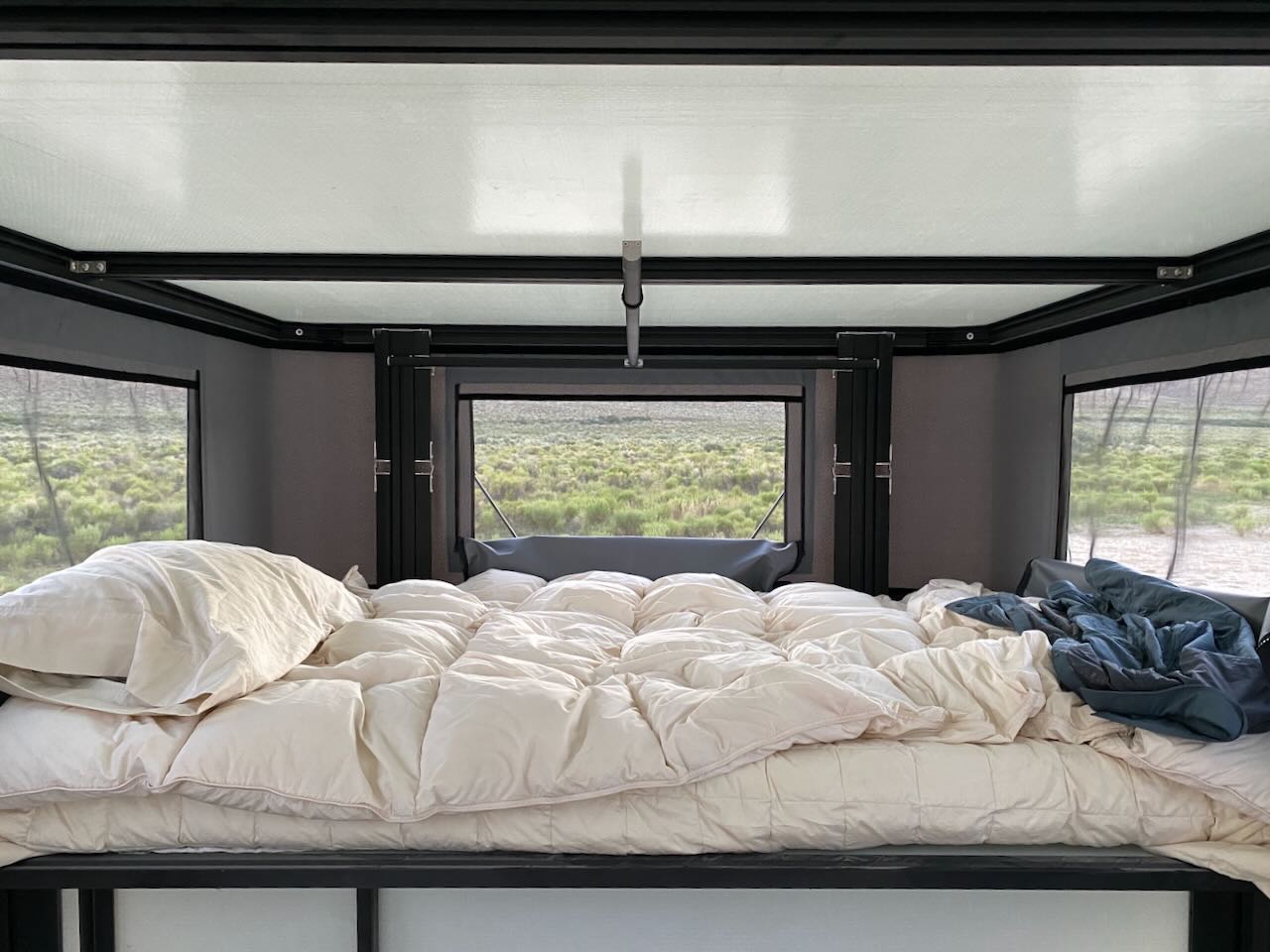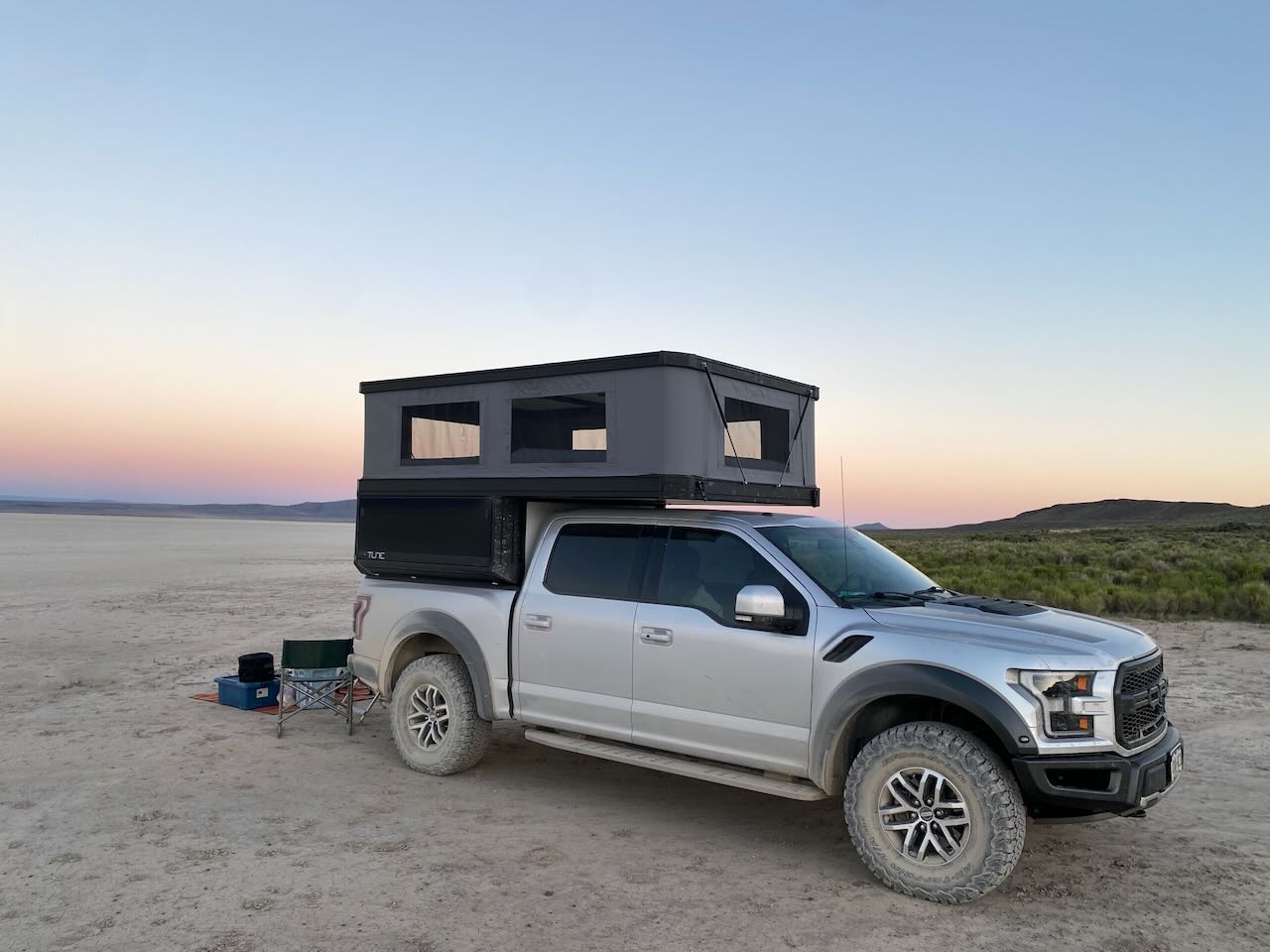When Tim, Tune Outdoor’s genial PR rep, dropped off a full-sized Tune Outdoor M1 truck camper for an extended Expedition Portal test run, I was struck first by its austerity. As he opened the tailgate of the 2018 Ford F-150 Raptor demo vehicle to walk me through the M1, only three factory-installed options appeared to greet me: a mattress, a Yeti 1500 power station, and the portable battery’s mounting bracket. Other than that, the camper was bare—no fancy cabinets, no slide-out kitchen or expansive set of drawers, no complicated power management system, not even a roof vent. I was met with cold metal and glass and not much else. My first thought was, “I’m going to need to pack way more stuff if I’m supposed to live out of this thing for three weeks.”

But after I drove Tim to the airport and spent an hour evaluating the M1’s structure and construction I came to the conclusion that this was the perfect way to size up a mobile shelter like this one. Stripped of fancy gizmos or high-tech but potentially fragile accessories, any strengths and weaknesses of the camper itself would reveal themselves with more clarity. And, for my planned trip from Montana to Oregon for Overland Expo PNW, I would take the cue and simplify my own load out. The one concession I made to true convenience was hooking up my SnoMaster portable fridge to the Yeti power station. Otherwise, I pared down to the essentials—a single burner Cadac Safari 30 stove, my backpacking cookware and cutlery, a lantern, a chair and a simple aluminum table, and some bedding. I tossed in a hatchet and a handful of tools at the last minute and called it good.
In studying the build sheet, I discovered one final option installed on the Tune: the tempered glass side and rear body panels. With respect to the lightweight truck camper market, these fold-out panels are one feature that sets the M1 apart, and I wouldn’t order one without them. The other is its extra-wide structure. Rather than ending at the bedsides or even canting inwards, the Tune extends an extra 4 inches beyond the sides of the truck. The result is a negligible impact on the external profile of the camper but a huge effect on the living space inside.
Standing in the bed of the Raptor, I could spin in circles with my arms fully extended and never come close to touching the sides of the camper. This extra room, combined with the six mesh windows in the canvas pop-top (clear vinyl inserts are optional) and the glass side panels, make for an airy and expansive habitat where the outside is invited in. The icing on the cake, and perhaps my favorite element of the M1, is the translucent composite roof panel. It maximizes the light available, especially on cloudy days, and acts as a kind of gentle wake-up call in the mornings, as the rays of a sunrise gradually fill the camper from above—an excellent way to greet the day.

That trick roof rises up vertically from the body of the camper on gas struts via a single manually operated lever attached to the ceiling of the M1. The sequence for opening and closing the top proved to be a little bit awkward, and the struts on this example seemed to be slightly overcharged for the application, making shutting the camper something of a struggle. My only other critique also involved the pop-top. The canvas coverings for the mesh windows were manufactured with incredibly tight tolerances, so it was difficult to stretch them enough to match up the hook-and-loop closures around the entire opening, leaving one side or another (usually the top) unfastened and sagging. However, this M1 was an early-production run unit, and Tune assures me they’re constantly tweaking small inconsistencies like these, often based on customer feedback.

Looking at the hard dimensions, the full-size M1 I tested boasts nearly 7 feet of headroom and a 60-inch x 78-inch sleeping platform in the cab-over area. That’s queen-size territory for the East-West sleeping orientation, and Tune offers a North-South bed extender option that accommodates a nearly king-size mattress. Crucially, with the pop-top extended, there’s a generous 30.5 inches from the top of the 4-inch mattress to the ceiling of the camper. This makes sitting up in bed a less dangerous operation for your noggin, plus a comfortable place to wait out a storm, read a book, or write a camper review. The mid-size M1, which Tune engineers for trucks like the Toyota Tacoma and Chevy Colorado, has 6.5 feet of headroom and an interior width of 72 inches. The cab-over bed design effectively segregates the snoozing and living spaces, so there’s no time wasted setting up or taking down an intrusive sleeping platform.

Built from T-slot aluminum extrusion and composite corner sections, the M1 weighs in at only 360 pounds for the mid-size version and 450 pounds for the full-size. Fastened down tightly with proprietary clamps, the exceptionally rigid structure felt like a natural extension of the pickup. On a truck with a power curve and fuel consumption like a Ford Raptor, its presence is almost unnoticeable, and the Tune’s low profile when the pop-top is collapsed into travel mode contributes to its invisibility. On a less well-endowed vehicle, like a Tacoma, M1 owners might see a more obvious impact on performance and fuel economy.

But not if you keep your build simple. The M1 does feature over 440 feet of adjustable T-track on the inside and outside of the camper, so customization and installation of all kinds of add-ons is easy. Tune offers a range of upgrades and accessories, as well as personalized factory support, to help you launch your dream build. Each M1 is made-to-order and custom-built for your truck, so no two are alike, and I confess to sketching out a few plans of my own on quiet evenings in the Oregon desert. The Tune’s austerity turned out to be quite inspiring.
From $12,999 | tuneoutdoor.com
Our No Compromise Clause: We do not accept advertorial content or allow advertising to influence our coverage, and our contributors are guaranteed editorial independence. Overland International may earn a small commission from affiliate links included in this article. We appreciate your support.









